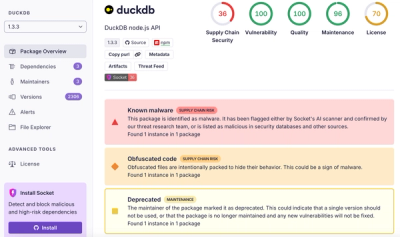
Product
Introducing Tier 1 Reachability: Precision CVE Triage for Enterprise Teams
Socket’s new Tier 1 Reachability filters out up to 80% of irrelevant CVEs, so security teams can focus on the vulnerabilities that matter.
@briebug/mat-dialog-schematic
Advanced tools
Generate Angular Material Dialogs in an Angular CLI project
This schematic will:
Install globally
npm install -g @briebug/mat-dialog-schematic
Then in an Angular CLI project run
ng g @briebug/mat-dialog-schematic:mat-dialog {name}
Issues with this schematic can be filed here.
⚙ Yarn is required for the scripts. Make sure it's installed on your machine.
⬇ Install the dependencies for the schematic and the sandbox application
yarn && cd sandbox && yarn && cd ..
🖇 Link the schematic in the sandbox to run locally
yarn link:schematic
🏃 Run the schematic
yarn build:clean:launch
To execute an example schematic, make sure you've ran the Install and Link steps above. Then run the following and inspect the changed files.
git checkout component-license && yarn build:clean:launch
Execute the schematic against the sandbox. Then run linting, unit & e2e tests and a prod build in the sandbox.
yarn test
Run the unit tests using Jasmine as a runner and test framework.
yarn test:unit
Running the schematic locally makes file system changes. The sandbox is version controlled so that viewing a diff of the changes is trivial. After the schematic has run locally, reset the sandbox with the following.
yarn clean
Note: if you're using the schematics CLI mentioned below, you can execute the schematic in a dry run mode.
schematic-starter and schematicStarter with the new name../src/schematic-starter/... to ./src/NEW_NAME/...yarn link:schematic to set up local package linking for the sandboxTo test locally, install @angular-devkit/schematics-cli globally and use the schematics command line tool. That tool acts the same as the generate command of the Angular CLI but also has a debug mode.
Check the documentation with
schematics --help
To publish, simply do:
npm run build
npm publish
FAQs
A schematic for generating mat dialog components
We found that @briebug/mat-dialog-schematic demonstrated a not healthy version release cadence and project activity because the last version was released a year ago. It has 6 open source maintainers collaborating on the project.
Did you know?

Socket for GitHub automatically highlights issues in each pull request and monitors the health of all your open source dependencies. Discover the contents of your packages and block harmful activity before you install or update your dependencies.

Product
Socket’s new Tier 1 Reachability filters out up to 80% of irrelevant CVEs, so security teams can focus on the vulnerabilities that matter.

Research
/Security News
Ongoing npm supply chain attack spreads to DuckDB: multiple packages compromised with the same wallet-drainer malware.

Security News
The MCP Steering Committee has launched the official MCP Registry in preview, a central hub for discovering and publishing MCP servers.